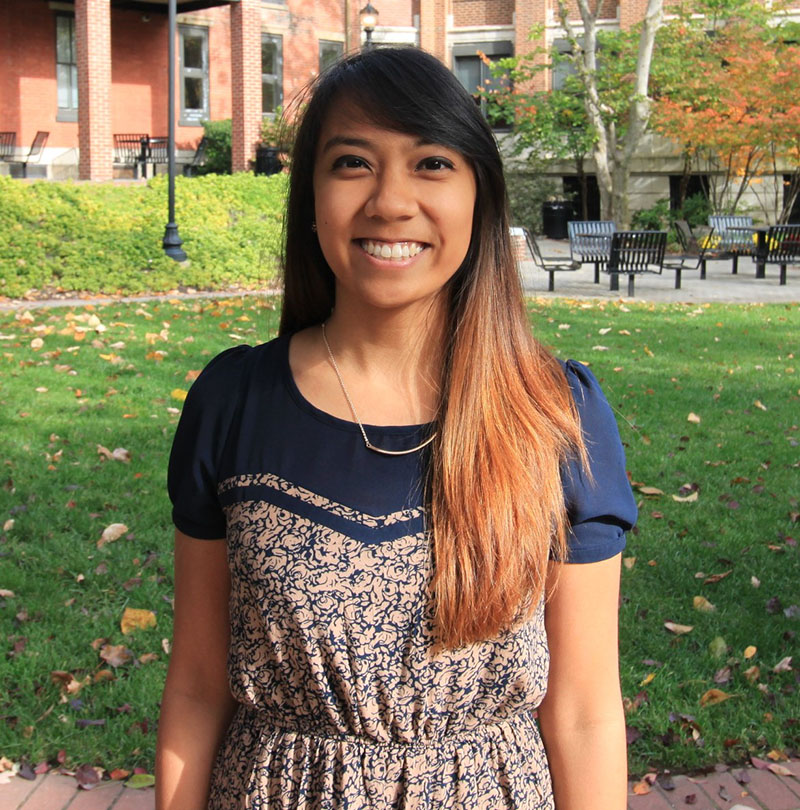By Lini S. Kadaba
 As a child, Angeline Aguinaldo ’17 always loved images. In fact, she wanted to grow up to be a film or documentary maker. Instead, she’s an engineering five-year B.S./M.S. student at Drexel University who uses pattern recognition software to analyze cell dynamics.
As a child, Angeline Aguinaldo ’17 always loved images. In fact, she wanted to grow up to be a film or documentary maker. Instead, she’s an engineering five-year B.S./M.S. student at Drexel University who uses pattern recognition software to analyze cell dynamics.
“Images have always been a lot easier for me to understand,” says Aguinaldo, 22, of Westfield, N.J., a senior pursuing a bachelor’s in biomedical engineering and a master’s in electrical engineering.
Her penchant for pictures spurred her undergraduate research that includes studying tumor cells. After taking a course on “Cell and Tissue Image Analysis” with Andrew R. Cohen, an associate professor of electrical and computer engineering, Aguinaldo wanted to work in his lab.
During her co-op over the spring and summer last year[2016], she analyzed data from The Wistar Institute as part of its project to better understand the role of mitochondria—a cell’s powerhouse—in the spread of cancer. The work contributed to the ground-breaking paper “A Neuronal Network of Mitochondrial Dynamics Regulates Metastasis,” which was published Dec. 19, 2016, in the respected journal Nature Communications and lists Aguinaldo as a co-author.
“My proudest moment was when it was officially published,” she says of her first publication, in review and edits for nearly a year. “It was pretty cool. [The research] has potential to direct therapeutics or medicine for tumor cells.”
Conventional wisdom held that mitochondria was not involved as the primary source of energy when a cell turns cancerous and metastasizes. Wistar scientists decided to take a closer look by studying mitochondria’s role in live prostate cancer cells and worked with Cohen’s lab.
“They actually found that mitochondria are not inactive and do have a very important role in tumor cells,” Aguinaldo explains. She helped develop and then use software to segment and track the 1,000 tiny, spaghetti-shaped mitochondria organelles in a single cell.
“Mitochondria are hard to distinguish,” she says. A single organelle is super tiny, 10 times smaller than the diameter of a strand of hair. Aguinaldo helped build complex algorithms and software tools to segment—distinguish mitochondria pixels from the noisy background—and then track a single mitochondria’s movement as the cancerous cell migrated.
The project involved examining 2,000-plus microscope-generated frames. You could say she did grow up to tell stories through images, after all.
“It took quite a bit of time,” she says of the analysis that made use of pattern recognition tools. “There definitely was a lot of frustration. It was a new environment for me. It was fast paced. But I got there.”
Cohen praised Aguinaldo’s contributions. “Angeline’s ability to jump right into this very complex problem and contribute with clear insights and analysis would be impressive for any engineer, but is even more remarkable in that she did this as an undergraduate research co-op,” he says. “This project was so successful that scientists from Wistar have come back to my lab to see how they can better engage Drexel students and co-ops in future research projects.”
In addition to research, Aguinaldo is active with the Drexel Newman Catholic Community and belongs to the engineering sorority Alpha Omega Epsilon. In 2014, she received Drexel’s Student Leader of the Year award, and the following year, she won the Charles E. Etting scholarship award.
The daughter of an engineer father and nurse mother, Aguinaldo says her academic interests marry her parents’ professions. “What I like about research is that you’re exposed to the most cutting edge technology and techniques in the industry, and once you apply them and enhance them, they have very meaningful applications,” she says. “They enhance the quality of life.”
Aguinaldo pursued undergraduate research from the get-go. Through the Research Experience for Undergraduates, she spent 10-weeks at a Princeton University lab working on lasers with medical applications. Aguinaldo was hooked on research. For the next couple of years, she studied optical brain imaging in the lab of Kambiz Pourrezaei, a professor in the School of Biomedical Engineering, Science and Health Systems. Since the mitochondria project, she has moved on to building automated imaging tools to detect cell mitosis, or division.
Her advice to others? “Expose yourself to anything,” she says. “If you have a particular interest, find it and try it.”